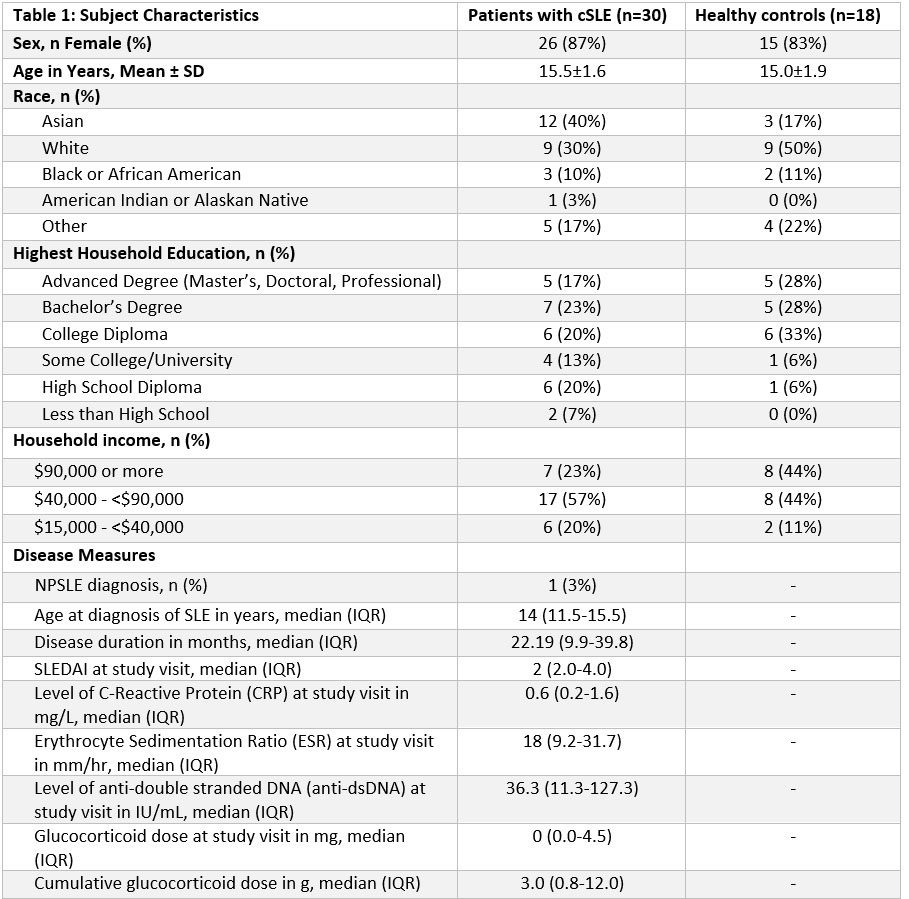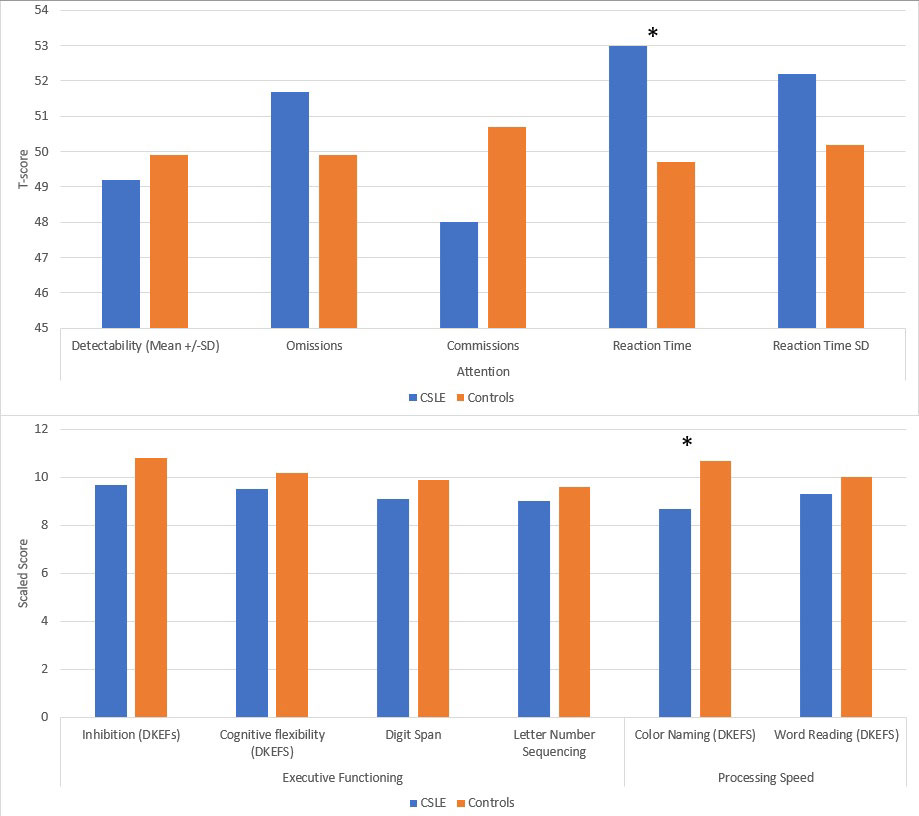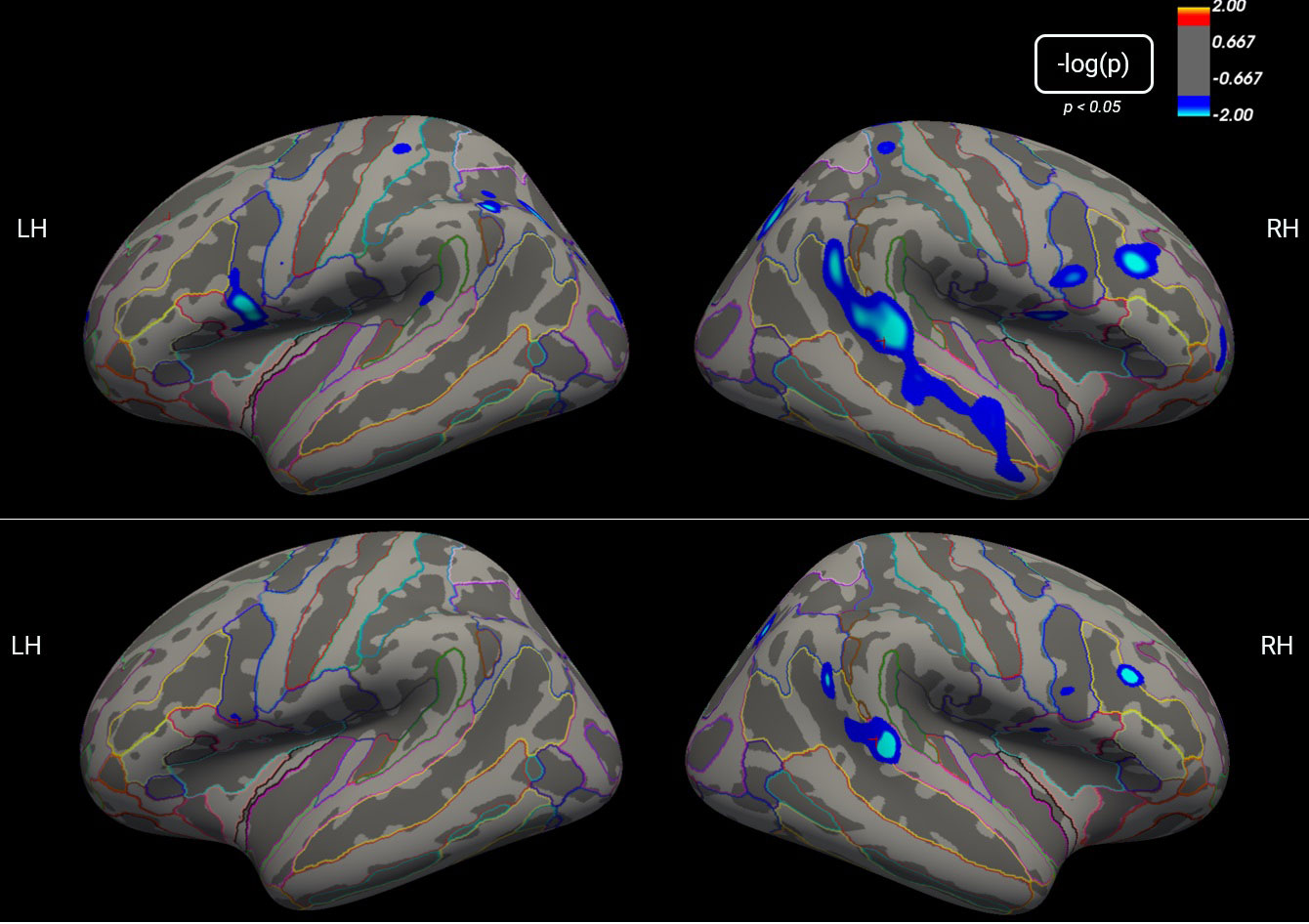Session Information
Date: Saturday, November 12, 2022
Title: Abstracts: Pediatric Rheumatology – Clinical I: Connective Tissue Disease
Session Type: Abstract Session
Session Time: 3:00PM-4:30PM
Background/Purpose: Cognitive difficulties are common in children with childhood-onset SLE (cSLE), but neuropsychiatric lupus (NPSLE) remains challenging to diagnose and treat. To increase understanding of underlying mechanisms, we examined the association of cortical surface area with cognitive performance and disease measures.
Methods: We examined a cross-sectional sample of patients with cSLE (ages 12-17) meeting ACR, SLICC or EULAR classification criteria and healthy controls (ages 12-17). Demographic and disease measures were collected from questionnaires and medical records, respectively. Subjects completed standardized cognitive tests on attention, executive function, and processing speed. We explored group differences using t-tests for each score. T1-weighted brain magnetic resonance images were obtained using a 3T scanner. The FreeSurfer software package was used to build cortical surface area maps for each subject. We probed structural differences between groups using a vertex-wise general linear model controlled for subject age and corrected for multiple comparisons. From this whole-brain analysis, only regions of interest (ROIs) showing significant group differences were considered for further analysis. We then examined the association between the surface area of each significant ROI and each cognitive task with significant group differences, using the Spearman correlation coefficient corrected for multiple comparisons. In the cSLE group, we used Partial Least-Squares Regression (PLS) to examine the association between disease measures and surface area in the significant ROIs.
Results: We recruited 30 patients with cSLE and 18 healthy controls; only one patient had a NPSLE diagnosis (Table 1). On average, lupus patients and controls scored within the normal range across cognitive tests. However, lupus patients performed worse than controls on measures of cognitive efficiency (attention reaction time p=0.056, processing speed colour naming p=0.02) (Fig. 1). Lupus patients were found to have a significantly reduced cortical surface area across 14 different ROIs when compared to controls (pcorr < 0.05), mostly in the right temporal and frontal lobes (Fig. 2). Brain-behaviour correlations suggest that reaction time is correlated with altered surface area in the left precentral area (pcorr=0.045), the right superior temporal gyrus (pcorr=0.046), post-cingulate gyrus (pcorr=0.042), the right middle frontal gyrus (pcorr=0.05) and the right intraparietal area (pcorr=0.056). In PLS analysis, cumulative steroid dose, and levels of CRP, ESR, and anti-dsDNA were found to be significant predictors of surface area.
Conclusion: Lupus patients exhibited cortical surface area abnormalities when compared to controls and performed worse on measures of cognitive efficiency. Structural abnormalities and poor cognitive efficiency were significantly associated. Cumulative steroid dose, CRP, ESR and anti-dsDNA were found to be significant predictors of brain surface area. Our findings suggest a relationship between disease activity, cortical surface area, and cognitive efficiency in patients with cSLE. Further study is needed to characterize the underlying mechanisms of this relationship.
To cite this abstract in AMA style:
Arciniegas S, Mossad S, El Tal T, Lishak V, Fevrier S, Mohamed I, Law J, Ng L, Moaf P, Branson H, Davis A, Hiraki L, Levy D, Danguecan a, Ibrahim G, Knight A. Cortical Surface Area Correlates with Cognitive Efficiency and Disease Measures in Childhood-Onset Systemic Lupus Erythematosus [abstract]. Arthritis Rheumatol. 2022; 74 (suppl 9). https://acrabstracts.org/abstract/cortical-surface-area-correlates-with-cognitive-efficiency-and-disease-measures-in-childhood-onset-systemic-lupus-erythematosus/. Accessed .« Back to ACR Convergence 2022
ACR Meeting Abstracts - https://acrabstracts.org/abstract/cortical-surface-area-correlates-with-cognitive-efficiency-and-disease-measures-in-childhood-onset-systemic-lupus-erythematosus/



